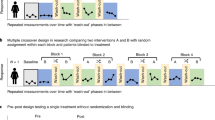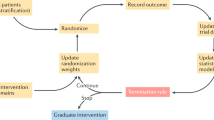Abstract
The results of clinical trials are often used as the basis for changes in clinical practice. Proper execution and interpretation of the results of trials are, therefore, of paramount importance to the welfare of patients. The results of a clinical trial are based on four key elements: the choice of the primary study end point, the method used to compare end points between groups, the clinically meaningful difference in the primary end point selected a priori by the investigators, and the power of the study to detect as statistically significant a difference between groups that is as large as the preselected clinically meaningful difference. These key elements directly follow from the primary hypothesis tested by the trial. This article reviews the basic features of these four elements, and the influence they have on the interpretation of clinical trials.
Key Points
-
Clinical trials should designate one clinical measure that is most relevant to the condition and treatment being studied as the primary end point
-
Effect sizes are useful unit-free measures of treatment effect, calculated as the change in the primary end point divided by its SD at baseline
-
The target treatment effect is the minimum degree of change that the trial is designed to detect as significantly different between the treatment groups, on the basis of a clinically meaningful difference in the primary end point
-
Levels of type I and type II statistical error indicate the likelihood that the trial results will be false positive or false negative
-
Post hoc subgroup comparisons should only be considered hypothesis-generating
This is a preview of subscription content, access via your institution
Access options
Subscribe to this journal
Receive 12 print issues and online access
$209.00 per year
only $17.42 per issue
Buy this article
- Purchase on Springer Link
- Instant access to full article PDF
Prices may be subject to local taxes which are calculated during checkout
Similar content being viewed by others
References
Friedman LM et al. (1996) Fundamentals of clinical trials, edn 2. St Louis: Mosby-Yearbook
Spilker B (1991) Guide to clinical trials. Philadelphia: Lippincott, Williams and Wilkins
Chow SC and Lui J (1998) Design and analysis of clinical trials. New York: John Wiley and Sons
Guyatt GH et al. (1993) Users' guide to the medical literature. II: how to use an article about therapy or prevention. A: are the results of the study valid? Evidence-Based Medicine Working Group. JAMA 270: 2598–2601
Moher D et al. (2001) The CONSORT statement: revised recommendations for improving the quality of reports of parallel-group randomized trials. JAMA 285: 1987–1991
Prentice RL (1989) Surrogate endpoints in clinical trials: definition and operational criteria. Stat Med 8: 431–440
Biomarkers Definitions Working Group (2001) Biomarkers and surrogate endpoints: preferred definitions and conceptual framework. Clin Pharmacol Ther 69: 89–95
Weir CJ and Walley RJ (2006) Statistical evaluation of biomarkers as surrogate endpoints: a literature review. Stat Med 25: 183–203
Felson DT et al. (1990) Time for change in the design, analysis, and reporting of rheumatoid arthritis clinical trials. Arthritis Rheum 33: 140–149
Forrow L et al. (1992) Absolutely relative: how research results are summarized can affect treatment decisions. Am J Med 92: 121–124
Rosenthal R (1991) Meta-analytic Procedures for Social Research, edn 2. Newbury Park: Sage Publications
Cohen J (1988) Statistical Power Analysis for the Behavioral Sciences, edn 2. Hillsdale: Lawrence Erlbaum
Liang MH et al. (1990) Comparisons of five health status instruments for orthopedic evaluation. Med Care 28: 632–642
Cook RJ and Sackett DL (1995) The number needed to treat: a clinically useful measure of treatment effect. BMJ 310: 452–454
Browner WS et al. (2001) Getting ready to estimate sample size: hypotheses and underlying principles. In Designing clinical research: an epidemiologic approach, edn 2, 51–64 (Eds Hulley SB et al.) Philadelphia: Lippincott, Williams and Wilkins
Guyatt GH et al. (1998) Interpreting treatment effects in randomized trials. BMJ 316: 690–693
Beaton DE et al. (2001) Looking for important change/differences in studies of responsiveness. OMERACT MCID Working Group. Outcome Measures in Rheumatology. Minimal Clinically Important Difference. J Rheumatol 28: 400–405
Browner WS et al. (2001) Estimating sample size and power: the nitty-gritty. In Designing clinical research: an epidemiologic approach, edn 2, 65–91 (Eds Hulley SB et al.) Philadelphia: Lippincott, Williams and Wilkins
Lenth RV (2006) Java applets for power and sample size [http://www.stat.uiowa.edu/~rlenth/Power] (accessed 7 May 2006)
Piaggio G et al. (2006) Reporting of noninferiority and equivalence randomized trials: an extension of the CONSORT statement. JAMA 295: 1152–1160
D'Agostino RB Sr et al. (2003) Non-inferiority trials: design concepts and issues—the encounters of academic consultants in statistics. Stat Med 22: 169–186
Greene WL et al. (2000) Claims of equivalence in medical research: are they supported by the evidence? Ann Intern Med 132: 715–722
El-Masri MM and Fox-Wasylyshyn SM (2005) Missing data: an introductory conceptual overview for the novice researcher. Can J Nurs Res 37: 156–171
Garrett AD (2003) Therapeutic equivalence: fallacies and falsification. Stat Med 22: 741–762
Hollis S and Campbell F (1999) What is meant by intention to treat analysis? Survey of published randomized controlled trials. BMJ 319: 670–674
DeMets DL and Califf RM (2002) Lessons learned from recent cardiovascular clinical trials: part I. Circulation 106: 746–751
International Conference on Harmonisation of Technical Requirements for Registration of Pharmaceuticals for Human Use (online 5 February 1998) ICH Harmonised Tripartite Guideline. Statistical Principles for Clinical Trials E9 [www.ich.org/LOB/media/MEDIA485.pdf] (accessed 3 May 2006)
Guyatt GH et al. (1994) Users' guide to the medical literature. II: how to use an article about therapy or prevention. B: what were the results and will they help me in caring for my patients? Evidence-Based Medicine Working Group. JAMA 271: 59–63
Hayward RA et al. (2005) Reporting clinical trial results to inform providers, payers, and consumers. Health Aff 24: 1571–1581
Acknowledgements
This work was supported by the Intramural Research Program, National Institute of Arthritis and Musculoskeletal and Skin Diseases, National Institutes of Health.
Author information
Authors and Affiliations
Ethics declarations
Competing interests
The author declares no competing financial interests.
Rights and permissions
About this article
Cite this article
Ward, M. Primer: measuring the effects of treatment in clinical trials. Nat Rev Rheumatol 3, 291–297 (2007). https://doi.org/10.1038/ncprheum0478
Received:
Accepted:
Issue Date:
DOI: https://doi.org/10.1038/ncprheum0478
This article is cited by
-
Measuring Treatment Effects in Clinical Trials Using Cardiac MRI
Current Cardiovascular Imaging Reports (2011)



